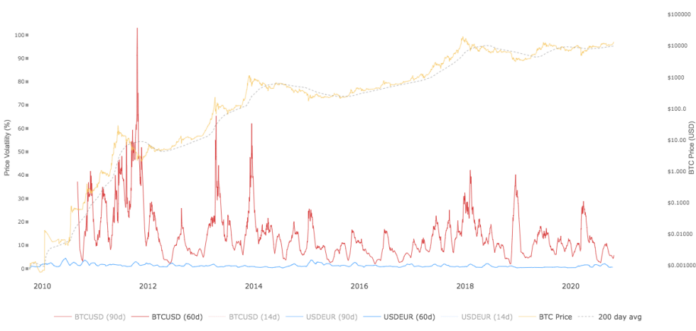
Since it was introduced in 2009, one of the biggest knocks against Bitcoin has been its lack of price stability. Bitcoin volatility has been a much-discussed topic over the past decade. Some believe that the price of Bitcoin is not stable enough to be used as a currency, while others believe that its price is becoming more stable with each passing day.
To find the truth about Bitcoin volatility, you must take a look over time at the price of this digital asset and how it’s changed over the years.
The Volatility Problem
Bitcoin supporters can tout the digital asset all they want, but if its price does not maintain price stability it will likely never become a globally used currency for daily purchases. Think about buying a cup of coffee. When you walk into any coffee shop you have a good idea of how much that coffee will cost. Not only that, but you know that when you walk back into that same coffee shop tomorrow or next week, its price won’t change. That’s because the fiat currency used to price the coffee is relatively stable, and doesn’t fluctuate much on a regular basis. If, for instance, the underlying currency fluctuates greatly each day, you might walk into the coffee shop to see that the coffee costs 25% more today than it did yesterday. This is why price-volatile currencies are not realistic for daily use.
Historic Volatility
In the early days of Bitcoin, there were no exchanges to facilitate trading, making it difficult to value the digital asset. It took several years before its price rose above $1, but by the end of 2012, its price was expanding exponentially. 2013 was the year Bitcoin saw its first explosion, initially heading above $100 and then upwards of $1,000.
Unfortunately, over the next few years, the price of Bitcoin crashed more than 70%, leading to a bear market that lasted until late-2015. However, as the Chinese Renminbi began depreciating, Bitcoin saw its price once again begin to skyrocket into the thousands. Then, in 2017, the latest Bitcoin bull run came into the picture, running the price up close to $20,000. But these prices wouldn’t be sustained. By the end of 2018, the price of Bitcoin dropped to below $4,000 before shooting up above $10,000 by June of the same year. But after a relatively calm 2019 came and went, 2020 became the year to watch.
As you can see, historically Bitcoin has seen its fair share of price swings. Yet, over the years, these swings have lessened, and changes in price haven’t been as extreme. As you can see, the volatility spikes in Bitcoin were most extreme in 2011, with subsequent spikes in volatility lessening over time. This points to an asset that is becoming more and more price stable.
Volatility in 2020
In March 2020 Bitcoin surged back above $10,000, making investors happy, but leading many to believe that the volatility problem was rearing its head once again. Yet, this was short-lived, and Bitcoin price volatility quickly headed lower in May before bottoming out in August. In fact, the volatility of Bitcoin has leveled-out so much that it now is a more stable asset than oil, emerging market currencies, and even the US real estate market.

This is an important milestone for an asset that has consistently been viewed as extremely risky and volatile. In fact, when examining the risk-adjusted returns of Bitcoin compared to other assets, it appears the cryptocurrency provides even more stability than its counterparts.
Making Headway
It’s true that the volatility of Bitcoin is still greatly higher than traditional fiat currencies. But that doesn’t mean that progress over the years hasn’t been made. In fact, Bitcoin’s volatility is at its lowest point in years, showing signs of progress.

Bitcoinist.com is author of this content, TheBitcoinNews.com is is not responsible for the content of external sites.
Our Social Networks: Facebook Instagram Pinterest Reddit Telegram Twitter Youtube











